<continue reading>
First off, I should note that I've used True Image twice since last week's lesson. The first time was a large program I was evaluating and was planning on removing anyway, but — please note — rather than uninstalling it from the system and having it possibly leave behind scads of miscellaneous files and Registry entries, I opted to just rewrite the system with an image file and it's as if the program was never installed. Much cleaner that way over the long term.
The second time was the classic — where some wayward video program screwed up some other video program. Rather than remove it and hope everything went back to normal, I grabbed the latest image file and threw it in. Ten minutes later and I've got a perfectly-working system. The image file backup routine is truly one of the greatest computer innovations in the past decade.
Overview
This is written with two types of people in mind; those who want to leave the general looks and feel of Windows alone, but want to take care of the background stuff, and those who want to trim it down to a lean, mean, fightin' machine. I'll let you know when a tweak will make a major visual change on your system.
Most of these are just option boxes we're selecting, so if you don't like it, just uncheck the box and you're back to where you started.
Note: Depending upon how the system was initially set up, your "user name" might be your actual name (or handle) if you created it, or some company name like "DellHome" or "Compaq". Click on the Start Menu and down at the bottom you should see "Log Off" followed by your user name. When I refer to "user name", that's what I mean.
Background Programs
No question, the most important thing you can do for your computer is to make sure it's only running the background programs it should be. These are programs that load up in the background while Windows is booting up. The unnecessary ones just take up memory and clog up the system. When this really becomes important is on older machines that don't have gobs of memory. You get enough things burning up memory in the background and, the next thing ya know, some program isn't opening up because you've run out of memory.
First, download Startup.exe. It doesn't require an install. Just copy the folder to a permanent home, then grab the Startup.exe icon with the left mouse button and d-r-a-g it over to the Start Menu and drop it in for future access.
Fire up Startup.exe. This panel is empty with a brand-new Windows, so everything you're seeing has been added later. As such, we note that you can't actually 'break' Windows by disabling any of these.
Except for the programs you actually want running in the background, like firewalls and anti-virus programs, most of these are unnecessary. Some are trying to phone home when you fire up the program (to give the company demographic info on its users) and others are simply pre-loading program files so they won't take so long to load up when you run them. Now and then an entry will do nothing more than place the program's icon in the SysTray; the little area just to the right of the Task Bar.
The trick, of course, is to figure out which ones should stay. While it's somewhat rare, some programs actually do require something be run in the background during startup; running it later won't work. I can think of two (but only two) examples:
- Adobe Acrobat, the program that makes PDF files, needs a program called 'Distiller' run during boot-up or no-worko.
- True Image puts in two background files. I can't remember the name of the one that can be tossed, but the "Scheduler2" one stays or the program won't work.
The nice thing about Startup.exe (compared to the Windows program MSConfig) is that we can temporarily disable things, reboot, then test them out. If something's amiss, just re-enable it and reboot.
Looking over the Startup panel, you'll recognize some things and not others. The bigger programs, like firewall/anti-virus/anti-spyware programs might have a bunch of entries, but you can tell who they go to by the location on the C Drive.
For the ones you don't recognize, you can track most of them down by their location. Even if the folder name is the name of the company (not the program) and you don't recognize it, you can always go into the folder and run the program to see what it is. If it's just some normal program, go ahead and disable the entry, reboot, then test out it out. If it runs fine, then you don't need the background program.
On that note, when I say "test", I mean it, in the sense that Adobe Acrobat will load up and work fine — it just won't save a PDF file without that Distiller program being run during boot-up.
If you're still not sure what it is, the next step would be to do a Google search for it, and make sure to type in the whole command, like "schedhlp.exe". A bunch of security sites and web forums will pop up and you'll be able to tell what it goes to and, for that matter, whether or not it's harmful.
Speaking of which, you should memorize the ones that are normally there so you can spot an intruder if something slips past your anti-virus or spyware program. The first thing I'd do would be to run over to Google and see what it is.
Once you've 'Disabled' a background routine and have verified you don't need it, you can delete it to clean things up.
Window Layout
Open the 'My Computer' folder, make sure no other folders are open:
- From the View Menu, make sure 'Status Bar' is checked.
At this point we're going to make our first radical change from the WinXP look. If you don't like something, just change it back:
- Go to Tools Menu, 'Folder Options', check 'Use Windows classic folders'. As noted in the last lesson, I prefer to have each folder open its own window, which is the "Open each folder in its own window" setting. Try it for a while and see if you like it. It's more confusing at first, but, in the long run, it'll give you a much better feel for where the files are in regards to their placement on the system.
Note: Sometimes it slips back to 'same window' mode after the next reboot, so set it back to 'own window' and that'll take care of it.
- If you're opening each folder in its own window, go to View Menu, 'Toolbars', and uncheck the top two entries.
View Menu, select 'Icons'.
View Menu, 'Arrange Icons by':
- Uncheck 'Show in Groups' if it's checked
- Check 'Auto Arrange' and 'Align to Grid'
Tools Menu, 'Folder Options', 'View' tab:
- Unless you're using a networked printer or computer, uncheck "Automatically search..."
- Check "Show hidden files"
- Uncheck "Hide extensions", "Hide protected" and "Show pop-up"
- Click "Apply to All Folders"
What we're basically doing here is de-XPing your Windows. This is how folder windows have always behaved until XP came along. You can see now that they knocked themselves out trying to make it easy for beginners, but if you're doing these lessons, you are way beyond that point. A couple more steps will complete the deXPification of your system.
Control Panel
Let's take a dash through the Control Panel, accessed via Start Menu/Settings.
Administrative Tools:
- If you'd like to change the drive letter of any of the drives (except the C), open Computer Management, "Disk Management". Highlight the entry with the right mouse button, "Change drive letter". Change the letter, and sometimes it requires a reboot. If you're changing the drive letter of a ROM drive, put a disc in the drive first, change the drive letter, then leave the disc in the drive during the next reboot.
Display:
- Themes:
- This is the second place we make a major departure from the stock Windows look. If speed is your game and you want a sharp, snappy system, open the 'Themes' panel and select "Windows Classic". This reduces everything back to the mean bare-bones look of previous Windows versions.
- Desktop:
Click on "Customize Desktop", turn off the Desktop Wizard. Uncheck any icons you don't need on the Desktop, and we'll presume 'My Computer' is already checked. Down below I mention that I use different icons for my Desktop than the stock XP ones. This is where you change them.
- Appearance:
- 'Effects' button: For snappy systems, uncheck the top box. In the second area, if you have an LCD monitor, set it to ClearType and see how things like Web pages look.
- 'Advanced' button: If you want to adjust any of the colors on your system, like the top color bar in the windows or the 'highlight' text, click on the area in the small window and then adjust the colors down below. If you selected 'Windows Classic' up above, you'll probably want to tone down the background color unless you're going to use a background pic. I use an RGB color of 28-60-85. If you click on the 'Other' button, you'll see the Red-Green-Blue values over to the right.
If you're an old-timer from the Win95 days and miss that nice gold highlight it used, click on 'Selected' in the little window, then change the blue to RGB 250-212-78 and change the white to black.
Settings:
- Check to make sure it's set to 32-bit. Over to the left is where you adjust your screen resolution. If text on the screen seems tiny and you're always squinting at it, select the next-lower setting. Ditto moving it up a notch if things seem too big. This works in conjunction with the distance between you and the monitor. For each monitor size (17", 19", etc), there should be one perfect compromise between the distance and the screen resolution.
Fonts:
- If you ever add any fonts to the system, open this window and drop them in. They may not 'register' correctly using other means.
Keyboard:
- I prefer the Repeat Delay all the way to the right and the Repeat Rate right in the middle. That's how Win95/98/ME and 2K did it, so it's kind of odd that XP would go the other direction.
Mouse:
- Open the 'Motion' panel. The 'Speed' is how far the pointer moves in relation to your hand. 'Acceleration' is how quickly it moves depending upon how quickly you move your hand. I don't like any 'acceleration' at all so I turn it off, although I like a fairly 'quick' mouse which you get by adjusting the 'Speed'.
If you want to test the 'speed', put your mouse on one side of the screen, close your eyes and move it how far you think it should be to hit the other side. Or, if you're constantly overshooting or undershooting some small gadget box that you're aiming for, adjust the speed.
 The 'Pointers' panel is where you change mouse pointers. If you want to try out the cool animated 'busy' pointers from the old Win98 add-on pack (over to the right), here they are.
The 'Pointers' panel is where you change mouse pointers. If you want to try out the cool animated 'busy' pointers from the old Win98 add-on pack (over to the right), here they are.
Power Options:
- Power Schemes: I turn the monitor and hard drive off after an hour. I never use System Standby.
- Hibernate: Make sure it's off.
Scheduled Tasks:
- Unless you're actually using something here, delete every icon except the "Add Task", then select "Stop using..." from the Advanced Menu.
System:
- System Restore: I turn this off since I prefer drive images for any kind of restorative work.
- Automatic Updates: Make sure this is on unless you're a geeky type who wants to do it manually.
- Remote: Turn off!
- Advanced: This is another departure from the stock Windows look and feel. If you're going for a snappy system, click on "Settings", then uncheck anything that starts with "Animate", "Fade" or "Slide", and un-check the last entry.
Note: The stock WinXP Desktop look might come back when you're finished with this area. If it does, open 'Display' again and set it back to 'Windows Classic (Modified)'.
- Error Reporting — Disable!
Task Bar and Start Menu:
- Taskbar: Personally, I like the Task Bar to get the hell out of the way when not in use so I check 'Auto-hide'. I don't care for the "Group similar" feature, but some people love it. It's especially handy if you're opening, like, 15 MS Word documents at a time. I also like the Task Bar at the top of the screen, rather than the bottom (ex-Amiga and Mac users will relate), so I 'unlock' it, then grab it with the mouse and d-r-a-g it up to the top of the screen.
You might give it a try, just for fun. As I indicated, Amigas and Macs kept their 'title bar' at the top and it seems much more natural. They are, after all, called "drop-down" menus.
- Start Menu: Click "Classic Start menu", "Customize". Check "Show small icons", uncheck "Use Personalized Menus".
Go check your Start Menu and you'll probably be surprised why everything looked so gigantic before. Again, it's just XP placating the newbies.
User Accounts:
The 'Scheduled Tasks' feature allows you to pop up a Notepad file at a certain time & date to act to a reminder to watch some TV show, dentist appointment the next morning, etc, or run some program when you're away from the computer. A very handy tool. It requires a system password, though, so if you're planning on using the feature, open 'User Accounts', click on your user name, then, if it says "Create a password", do so. If it says "Change password", then you already have one.
Please note that the system will now require a password whenever you boot up, but the TweakUI program, below, can do it for you automatically.
To use 'Scheduled Task' with a Notepad file, first make the reminder file in Notepad and call it something like "remind1.txt". Then run 'Add Task' and 'Browse' to the Notepad file. Select when you want it to run, enter your system password and that'll do it.
Windows Firewall:
- Assuming you're using a firewall program, make sure this is off. If you're not, make sure it's on. It won't keep out a serious hacker, but it might keep out the local high school Hackers 'R Us club.
TweakUI
This is a free Microsoft program. If you didn't install it last week, do so now. It's about halfway down the nav bar on the right. It's just a quick Next-Next-Next installation.
General:
Mouse:
- Slide it over to "Fast" to make your drop-down menus quicker.
Explorer:
- Uncheck "Prefix shortcut to" to get rid of that silly "Shortcut to..." that's put in front of shortcut icon names. Uncheck anything you don't want cluttering up the Start Menu.
Taskbar:
My Computer:
- Uncheck these if you don't want them showing in the 'My Computer' folder.
My Computer/Special Folders:
- As we discussed in last week's lesson, this is how you move your browser Favorites to a different location. Otherwise, don't touch any of these unless you know what you're doing.
My Computer/Templates:
- The only ones you wanted checked are things that you might actually make a "New" one of, such as a Notepad document.
You can also make up MS Word, Wordpad, HTML, etc, 'masters' with your own personalized touches and then 'Create' new entries, or overwrite the existing ones. In the future, when you open a new MS Word document, for example, it'll already have all of your custom features, such as page spacing, margins, size & type of font, etc.
Logon/Autologon:
- If you have a system password to log on with, this will do it automatically.
Recycle Bin
If you're tired of that pesky requester popping up every time you delete a file, click on the 'Recycle Bin' icon with the right mouse button and open 'Properties'. Uncheck the 'Display...' box.
It's to note that you're not really "deleting" files when you delete them from Windows. All you're really doing is moving them to the Recycle Bin, and there they'll be should you — ten minutes later — go "Oops!" The Recycle Bin rolls the old files off the back end as new ones are added. It should also be mentioned that by default the Recycle Bin is going to use up 10% of your hard drive space whether there's anything in it or not, so constantly emptying it doesn't 'save' you anything.
Killing Windows Messenger
Unless you use it, you want to kill this baby dead, not just disable it. It's a classic 'open port' for outside hackers. Do the following:
- Open Notepad. Browse to the C Drive, 'Windows' folder, then the 'inf' folder. It's a 'hidden' folder, so if you don't see it listed, go to the Tools Menu in any window, open 'Folder Options', 'View' tab, then check the "Show hidden files and folders" gadget.
- Open "sysoc.inf". Look for the line that starts with "msmsgs=" then delete the word "hide", but leave the commas. Save the file.
- Open Control Panel, 'Add or Remove Programs', then click on the 'Windows Components' button on the left.
- At the bottom you'll see two 'Windows Messenger' entries. Only uncheck the bottom one. It's confusing because the other box stays checked, but that's how you do it. If you open the "Windows Components" box afterward, both Windows Messenger boxes should be unchecked.
Desktop
This doesn't have anything to do with machine operation, but as long as we're cleaning everything else up, you should spend some time with your Desktop. Shall we compare?
Here's mine:
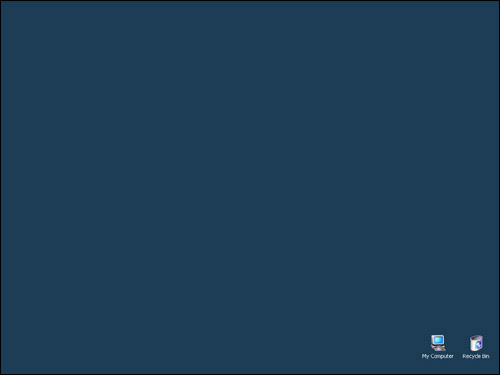
So, how's yours look?
(Just so you're not confused, the two icons above are from Windows Millennium, just because I think they look nicer than the XP icons with a solid color backdrop. If you'd like to give them a spin, they're here.)
That plethora of Desktop icons you currently have cluttering up the place are most likely:
- Actual files of one type or another. These might be downloads, files copied over from a CD, or files you've made yourself. All of these should be somewhere on the D Drive. You should have a 'Downloads' folder for downloads, a 'Temp' folder for things you're not sure what to do with yet, a 'Misc' folder for general oddball things, etc. etc. Wherever they are, they should not be on the C Drive, as that's (by far) the most likely drive to melt down.
And remember that the icons with the little arrows in the bottom-left corner are NOT the actual files, just shortcuts to them. If you're trying to find the actual file, open the 'Properties' of the shortcut icon and the location will be in the 'Target' box.
- Shortcut icons to web sites. These should be saved in the browser using the Favorites Menu, 'Add to Favorites'. This area, too, should be organized into the types of sites the icons go to.
The Desktop should be looked at as a 'quick save' option. For example, I removed three shortcut icons from my Desktop to snap the above screen-grab. They were all from sites I'd visited this morning and I either wanted to read them later or incorporate them into an article. At some point later on today I'll do both and then delete the icons. That's how the Desktop should be viewed.
As I said earlier, this doesn't have anything to do with system performance, it's more of a subliminal thing. Uncluttered Desktop equals uncluttered mind? Feeling like you're in control of your computer environment, rather than being overwhelmed by it? Something like that.
The Startup Menu
This section is a bit complicated, so if you need to take a breather, come back to it later.
The reason it's a bit complicated is because Windows divides up the entries in the Startup Menu into two categories, "all users" and "<your user name>". Programs in "all users" can be accessed by anyone who logs onto the computer; the ones in <user name> can only be accessed when that person logs on.
Security Note: When I say "accessed", I mean via the Start Menu. The actual programs are still sitting right there on the C Drive and can be run by anyone who knows how to dig up the program folder. So if you're trying to keep your computer-savvy 12-year-old from accessing your 'Best of Girls Gone Wild' program, don't count on this method. It's for convenience, not security.
If you open up the C Drive, 'Documents and Settings', you'll see the 'All Users' folder and the "user name" folder. Each of these folders contains a folder we need to access.
Now click on the Start Menu icon with the right mouse button and select 'Open'. This is how you'll normally access your Startup Menu entries. Take a look at some of the programs so you'll recognize it again, then close it down.
Back to the 'Documents and Settings' folder, open your <user name> folder. Inside, you'll see the 'Start Menu' folder, which is the one you just opened via the Start Menu button. Open it and you'll see the files you saw a minute ago.
In that folder you'll see a 'Programs' folder. If you open it up, you'll notice that it matches up with roughly half of the icons in the 'Program Files' area of the Start Menu. As I said, Windows divides them up, and this is half of them.
Now go back to the 'Documents and Settings' folder and open the 'All Users' folder. As before, you'll see a 'Start Menu' folder and, inside of that, a 'Programs' folder. Inside of the 'Programs' folder are the other half of the Start Menu icons.
Now do this:
- Click on that last 'Programs' folder icon with the right mouse button and 'Create Shortcut'.
- Rename the shortcut icon to something like "Start2" or "OtherStart" — something to show that this is the other startup folder than the main one in your <user name> folder.
- Now copy the 'Start2' folder over to the 'Programs' folder in your <user name> folder.
- Close down every folder on the Desktop.
Again click on the Start Menu icon with the right mouse button and 'Open'. You should see a bunch of unsorted icons and folders and, somewhere in there, your 'Start2' folder. Open it and you should see the other bunch of unsorted icons.
And now it's up to you to sort them all.
(As the crowd panics and breaks for the door, Doc thinks feverishly!)
Hey, guys, wait a sec! Have you seen these hot new RAM chips?
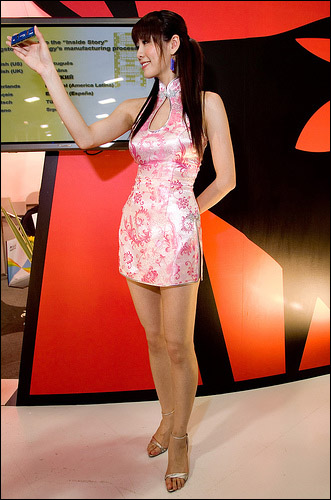
Yeah, I hear they're pretty good! And getting more compact all the time!
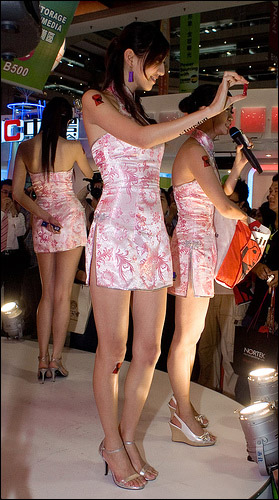
By the way, have I introduced you guys to my new girlfriend, Sheena? She's so natural and wholesome!
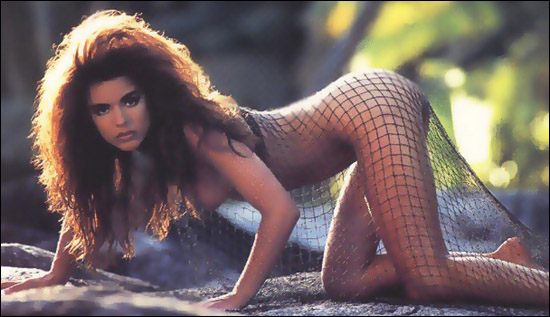
Okay! Well, it's great you guys stuck around! Let's get back to work!
Open the startup folder via the Start Menu button. This is where your main categories go. Here's what my folder looks like:

('DTP' stands for Desktop Publishing, like word processing programs and such)
When you've installed a program and want to move its icon to the proper area, open the 'Programs' folder. That's our main one in the '<user name>' folder. The icons will either be inside of it, or the 'Startup2' folder inside, which is the "all users" startup folder.
Once you find the program's icon, grab it with the mouse, d-r-a-g it to the correct area, then delete the rest of the junk that came with the program. 99% of the time, all you want is the main program icon.
Inside of each folder should be just the program icons, nothing else:
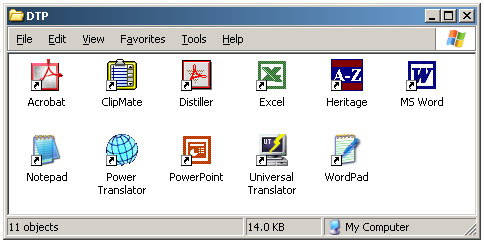
Which translates to this on the Start Menu:
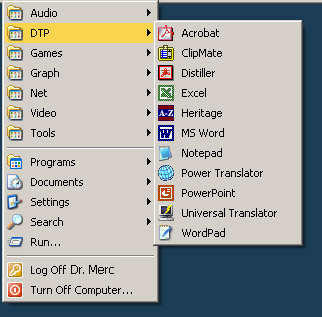
You want a quick, efficient system where you don't have to constantly be looking for things? This is how ya do it.
We Forgot Something Dept.
Sure, your system looks and feels snappy — but what about the audio environment?
This is a fun effect. It's a little whoosh! sound that plays whenever you minimize and maximize a window or program. Your friends will think it's pretty cool, and kids love it.
- Right-click on this whoosh sound, 'Save Target As...', then save it to your C:\Windows\Media folder.
- Open Control Panel, Sounds and Audio Devices, 'Sounds' tab. Set 'Maximize', "Minimize', 'Restore Down' and 'Restore Up' to the 'whoosh' sound from the long drop-down menu. (To undo them, select 'None')
If that doesn't make your system feel snappy, nothing will.
Summation
At this point, assuming everything's working, you should certainly make a backup image file if you're into the scene.
Things might look a little strange at first, but this is really the time-honored way Windows has been run over the years, and it was silly of XP to kowtow to a bunch of rank beginners and change it so dramatically from the sleek beast she is. When you get Windows pared down to its knuckle-dragging roots and get rid of all the bells & whistles and background programs clogging up the works, Windows is a very solid, robust operating system.
Next Up
Now that we've spent a few lessons getting your system cleaned up, it's time to get you cleaned up. Next week's lesson is going to be on ergonomics, with the goal to make your computer easier (on you) to operate, and to eliminate any long-term aches and pains.
See ya then!


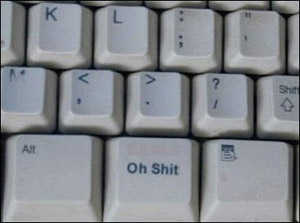 This is a weekly Saturday morning feature that will slowly, over time, turn you into a full-fledged computer expert. More info
This is a weekly Saturday morning feature that will slowly, over time, turn you into a full-fledged computer expert. More info 






In an effort to round out Maggie's Farm and make it truly eclectic, Bird Dog has invited me to add the geek factor to the mix. But, rather than just adding a few geeky articles here and there, I thought it would be fun to actually get serious about the w
Tracked: May 02, 21:05
Project time! Okay, the big mean Dr. Mercury has been boring you to tears with lessons on ugly, sordid things like file structure and backing up systems and such, but today we're actually going to get our hands dirty. We're going to construct a local web
Tracked: May 16, 12:54
This is a weekly Saturday morning feature that will slowly, over time, turn you into a full-fledged computer expert. More info here. Lesson 7: Cool ToolsThe nightmare couldn't have happened to a nicer person.You.There you were, innocently saving a small
Tracked: May 23, 21:33
If you create a fair number of new projects, be it spreadsheets, desktop publishing brochures, word processing documents, web pages, pictures, songs or whatever, you'll be interested in this.There are actually two ways you can create a new project with al
Tracked: Jun 05, 12:04
This is a weekly Saturday morning feature that will slowly, over time, turn you into a full-fledged computer expert. More info here. Lesson 11: Troubleshooting Temper, temper!You work to keep your emotions under control when what you really want to do is
Tracked: Jun 20, 21:04
It's got the big, ponderous name of 'Scheduled Tasks', but I prefer the term 'Windows Alarm Clock'. As so often happens with the built-in Windows tools, 95% of a program's function might be completely worthless, but that last five percent...Got a doctor'
Tracked: Jul 31, 18:56
Tracked: Nov 29, 10:02
Tracked: Jul 10, 11:23
Tracked: Jul 10, 11:26
Tracked: Jul 22, 19:49
Tracked: Jul 22, 21:41
Tracked: Jul 23, 13:08
Tracked: Aug 28, 08:32